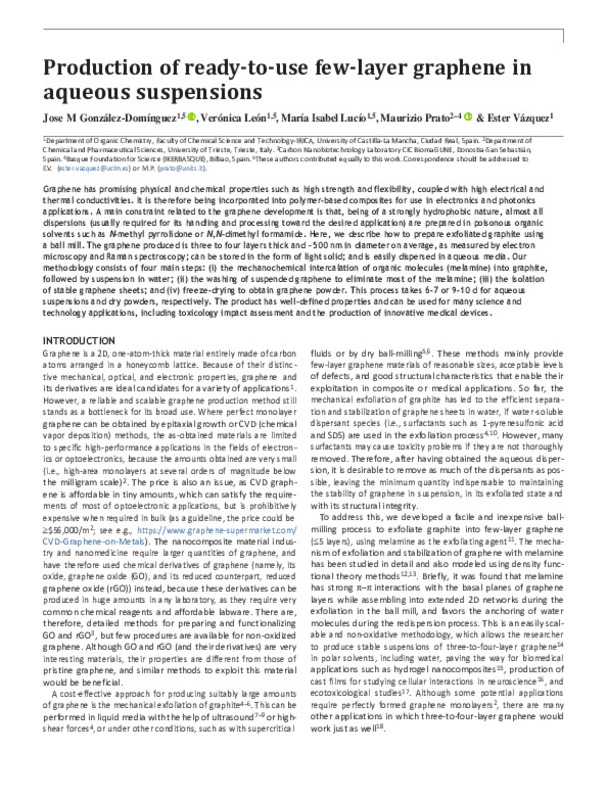JavaScript is disabled for your browser. Some features of this site may not work without it.
Buscar en RiuNet
Listar
Mi cuenta
Estadísticas
Ayuda RiuNet
Admin. UPV
Production of ready-to-use few-layer graphene in aqueous suspensions
Mostrar el registro sencillo del ítem
Ficheros en el ítem
| dc.contributor.author | González-Domínguez, Jose M.
|
es_ES |
| dc.contributor.author | León, Verónica
|
es_ES |
| dc.contributor.author | Lucío, María Isabel
|
es_ES |
| dc.contributor.author | Prato, Maurizio
|
es_ES |
| dc.contributor.author | Vázquez, Ester
|
es_ES |
| dc.date.accessioned | 2024-01-16T19:02:00Z | |
| dc.date.available | 2024-01-16T19:02:00Z | |
| dc.date.issued | 2018-03 | es_ES |
| dc.identifier.issn | 1754-2189 | es_ES |
| dc.identifier.uri | http://hdl.handle.net/10251/201950 | |
| dc.description.abstract | [EN] Graphene has promising physical and chemical properties such as high strength and flexibility, coupled with high electrical and thermal conductivities. It is therefore being incorporated into polymer-based composites for use in electronics and photonics applications. A main constraint related to the graphene development is that, being of a strongly hydrophobic nature, almost all dispersions (usually required for its handling and processing toward the desired application) are prepared in poisonous organic solvents such as N-methyl pyrrolidone or N,N-dimethyl formamide. Here, we describe how to prepare exfoliated graphite using a ball mill. The graphene produced is three to four layers thick and ~500 nm in diameter on average, as measured by electron microscopy and Raman spectroscopy; can be stored in the form of light solid; and is easily dispersed in aqueous media. Our methodology consists of four main steps: (i) the mechanochemical intercalation of organic molecules (melamine) into graphite, followed by suspension in water; (ii) the washing of suspended graphene to eliminate most of the melamine; (iii) the isolation of stable graphene sheets; and (iv) freeze¿drying to obtain graphene powder. This process takes 6¿7 or 9¿10 d for aqueous suspensions and dry powders, respectively. The product has well-defined properties and can be used for many science and technology applications, including toxicology impact assessment and the production of innovative medical devices. | es_ES |
| dc.description.sponsorship | We acknowledge financial support from the Spanish Ministry of Economy and Competitiveness (MINECO; projects CTQ2014-53600-R and CTQ2016-76721-R), through the EU Graphene-based disruptive technologies Flagship project (no. 696656). J.M.G.-D. gratefully acknowledges Spanish MINECO for his research grant (Formacion Postdoctoral). M.P., as the recipient of the AXA Chair, is grateful to the AXA Research Fund for financial support. M.P. was also supported by Diputacion Foral de Gipuzkoa (Spain), program Red (101/16). | es_ES |
| dc.language | Inglés | es_ES |
| dc.publisher | Nature Publishing Group | es_ES |
| dc.relation.ispartof | Nature Protocols | es_ES |
| dc.rights | Reserva de todos los derechos | es_ES |
| dc.subject.classification | QUIMICA ANALITICA | es_ES |
| dc.title | Production of ready-to-use few-layer graphene in aqueous suspensions | es_ES |
| dc.type | Artículo | es_ES |
| dc.identifier.doi | 10.1038/nprot.2017.142 | es_ES |
| dc.relation.projectID | info:eu-repo/grantAgreement/EC/H2020/696656/EU | es_ES |
| dc.relation.projectID | info:eu-repo/grantAgreement/MINECO//CTQ2014-53600-R/ES/MATERIALES BASADOS EN GRAFENO COMO SISTEMAS PROGRAMABLES MULTI-ESTIMULO-RESPUESTA PARA LA LIBERACION CONTROLADA DE FARMACOS/ | es_ES |
| dc.relation.projectID | info:eu-repo/grantAgreement/MINECO//CTQ2016-76721-R/ | es_ES |
| dc.relation.projectID | info:eu-repo/grantAgreement/Diputación Foral de Gipuzkoa//101%2F16/ | es_ES |
| dc.rights.accessRights | Abierto | es_ES |
| dc.contributor.affiliation | Universitat Politècnica de València. Escuela Técnica Superior de Ingeniería Agronómica y del Medio Natural - Escola Tècnica Superior d'Enginyeria Agronòmica i del Medi Natural | es_ES |
| dc.description.bibliographicCitation | González-Domínguez, JM.; León, V.; Lucío, MI.; Prato, M.; Vázquez, E. (2018). Production of ready-to-use few-layer graphene in aqueous suspensions. Nature Protocols. 13(3):495-506. https://doi.org/10.1038/nprot.2017.142 | es_ES |
| dc.description.accrualMethod | S | es_ES |
| dc.relation.publisherversion | https://doi.org/10.1038/nprot.2017.142 | es_ES |
| dc.description.upvformatpinicio | 495 | es_ES |
| dc.description.upvformatpfin | 506 | es_ES |
| dc.type.version | info:eu-repo/semantics/publishedVersion | es_ES |
| dc.description.volume | 13 | es_ES |
| dc.description.issue | 3 | es_ES |
| dc.identifier.pmid | 29446772 | es_ES |
| dc.relation.pasarela | S\364383 | es_ES |
| dc.contributor.funder | European Commission | es_ES |
| dc.contributor.funder | Diputación Foral de Gipuzkoa | es_ES |
| dc.contributor.funder | Ministerio de Economía y Competitividad | es_ES |







![[Cerrado]](/themes/UPV/images/candado.png)

